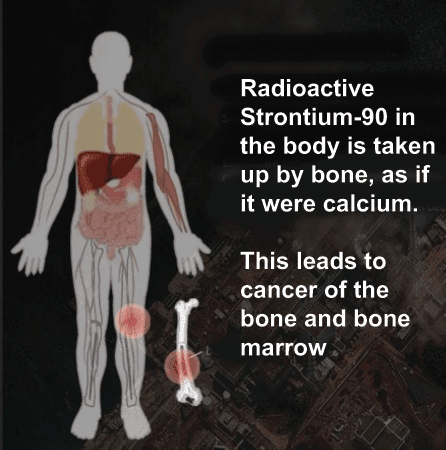Nuclear Waste Found to Contain Dangerous Levels of Strontium-90
By Theodora Filis
In 2001, 85,000 baby teeth were found in the Tyson Valley in St. Louis. They were part of 320,000 baby teeth collected for a project half a century earlier. Few people now know that the continental US is radioactive. The US has conducted more than 100 atmospheric nuclear tests at home and more than 100 in the Pacific. Ironically, vast amounts of radioactive material generated by nuclear testing ended up in the US.
The Environmental Protection Agency raised alarm over high levels of strontium-90. And, health advocates are accusing the Navy of covering up radioactive waste they say contains dangerous levels of strontium-90. The Navy is planning to turn over the radioactive wasteland, a 40-acre former shipyard parcel in San Francisco’s waterside Hunters Point neighborhood, to the city as early as next year and could be used for residential redevelopment. The accusations stem from 2021 Navy testing that found 23 samples from the property showing high levels of strontium-90, a radioactive isotope that replaces calcium in bones and causes cancer.
The 866-acre shipyard once held a secret navy research lab where animals were injected with strontium-90, and some officials suspect the waste was flushed down the drain. The isotope was also used to create glow-in-the-dark paint on the site, and it may have washed off ships used in testing nuclear bombs in the Pacific.
Strontium-90 is one of the most frequently released radioactive products in waste discharged from nuclear reactors. With a long half-life and chemical similarity to calcium, this radioisotope takes hundreds of years to decay to negligible levels and can accumulate in the food chain and bones, resulting in serious health hazards. As a result, there is growing interest in its fate and dispersion in the environment.It is widely dispersed in the environment and the food chain from atmospheric testing of nuclear weapons. Plants or crops growing in or near contaminated soil may take up small amounts of Sr-90 from the soil. Animals may ingest Sr-90 when eating plants.
It is also found in spent fuel rods in nuclear reactors and is considered a waste product. It is found almost everywhere in small amounts, due to past nuclear accidents and fallout from nuclear explosions. Part of polluted soils at sites where nuclear fission was used, including research reactors and nuclear power plants.
Strontium is not a regulated contaminant under the Safe Drinking Water Act.
It is also found in spent fuel rods in nuclear reactors and is considered a waste product. It is found almost everywhere in small amounts, due to past nuclear accidents and fallout from nuclear explosions. Part of polluted soils at sites where nuclear fission was used, including research reactors and nuclear power plants.
Most people are exposed to strontium through their diet and water because it occurs naturally in
the environment. Levels normally found in water and food are below levels expected to
cause harmful health effects. Strontium can also be in some toothpaste for sensitive teeth, which use
strontium chloride and/or strontium acetate.
Strontium supplements (strontium citrate or strontium
chloride) are widely available but have not been evaluated for safety or effectiveness by the U.S. Food
and Drug Administration.
The accident at the Chornobyl nuclear power plant introduced a large amount of Sr-90 into the environment. It was also released during the 2011 Japanese nuclear incident at the Fukushima Daiichi Nuclear Power Plant.
It can be inhaled, but when ingestion into food and water is of greatest health concern.
Once in the body, Sr-90 acts like calcium and is readily incorporated into bones and teeth, where it can cause cancers of the bone, bone marrow, and soft tissues around the bone. Because Sr-90 acts like calcium, milk monitoring is important.
Strontium is very similar to calcium and can replace calcium in the bone. This disrupts the normal bone
structure, leading to skeletal problems and defects. Infants, children, adolescents, and people who do
not get enough calcium are at higher risk of harmful health effects related to strontium exposure.
In 1963, one month before his assassination, President Kennedy declared a halt to atmospheric nuclear testing. American citizens were spared contamination from further atmospheric testing.
Recently, news broke showing radioactive contamination is not a thing of the past!
Labels: cancers, Chornobyl, contaminants, continental US, Fukushima Daiichi, nuclear testing, strontium-90


<< Home